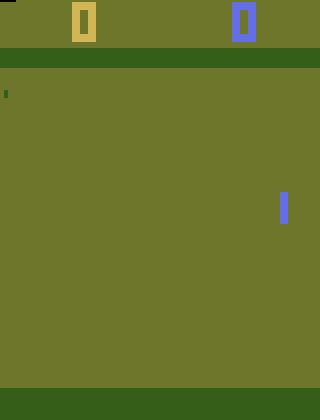Atari 2600: Pong with DQN (type-I q-function)¶
In this notebook we solve the Pong environment using the classic DQN agent. We’ll use a convolutional neural net (without pooling) as our function approximator for the q-function.
This version differs from the standard DQN version in that the q-function is modelled as a type-I q-function, i.e.
\[(s, a)\ \mapsto\ q(s,a) \in \mathbb{R}\]
instead of the standard (type-II):
\[s\ \mapsto\ q(s, .) \in \mathbb{R}^n\]
This notebook periodically generates GIFs, so that we can inspect how the training is progressing.
After a few hundred episodes, this is what you can expect:

import os
# set some env vars
os.environ.setdefault('JAX_PLATFORM_NAME', 'gpu') # tell JAX to use GPU
os.environ['XLA_PYTHON_CLIENT_MEM_FRACTION'] = '0.1' # don't use all gpu mem
os.environ['TF_CPP_MIN_LOG_LEVEL'] = '3' # tell XLA to be quiet
import gymnasium
import jax
import coax
import haiku as hk
import jax.numpy as jnp
from optax import adam
# the name of this script
name = 'dqn_type1'
# env with preprocessing
env = gymnasium.make('PongNoFrameskip-v4', render_mode='rgb_array') # AtariPreprocessing will do frame skipping
env = gymnasium.wrappers.AtariPreprocessing(env)
env = coax.wrappers.FrameStacking(env, num_frames=3)
env = gymnasium.wrappers.TimeLimit(env, max_episode_steps=108000 // 3)
env = coax.wrappers.TrainMonitor(env, name=name, tensorboard_dir=f"./data/tensorboard/{name}")
def func(S, A, is_training):
""" type-1 q-function: (s,a) -> q(s,a) """
body = hk.Sequential((
coax.utils.diff_transform,
hk.Conv2D(16, kernel_shape=8, stride=4), jax.nn.relu,
hk.Conv2D(32, kernel_shape=4, stride=2), jax.nn.relu,
hk.Flatten(),
))
head = hk.Sequential((
hk.Linear(256), jax.nn.relu,
hk.Linear(1, w_init=jnp.zeros), jnp.ravel
))
X = jnp.stack(S, axis=-1) / 255. # stack frames
return head(jax.vmap(jnp.kron)(body(X), A))
# function approximator
q = coax.Q(func, env)
pi = coax.BoltzmannPolicy(q, temperature=0.015) # <--- different from standard DQN
# target network
q_targ = q.copy()
# updater
qlearning = coax.td_learning.QLearning(q, q_targ=q_targ, optimizer=adam(3e-4))
# reward tracer and replay buffer
tracer = coax.reward_tracing.NStep(n=1, gamma=0.99)
buffer = coax.experience_replay.SimpleReplayBuffer(capacity=1000000)
while env.T < 3000000:
s, info = env.reset()
for t in range(env.spec.max_episode_steps):
a = pi(s)
s_next, r, done, truncated, info = env.step(a)
# trace rewards and add transition to replay buffer
tracer.add(s, a, r, done or truncated)
while tracer:
buffer.add(tracer.pop())
# learn
if len(buffer) > 50000: # buffer warm-up
metrics = qlearning.update(buffer.sample(batch_size=32))
env.record_metrics(metrics)
if env.T % 10000 == 0:
q_targ.soft_update(q, tau=1)
if done or truncated:
break
s = s_next
# generate an animated GIF to see what's going on
if env.period(name='generate_gif', T_period=10000) and env.T > 50000:
T = env.T - env.T % 10000 # round to 10000s
coax.utils.generate_gif(
env=env, policy=pi, resize_to=(320, 420),
filepath=f"./data/gifs/{name}/T{T:08d}.gif")